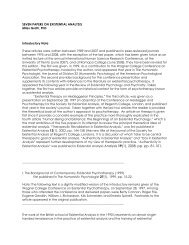The Sonate auf Concertenart: A Postmodern Invention? David ...
The Sonate auf Concertenart: A Postmodern Invention? David ...
The Sonate auf Concertenart: A Postmodern Invention? David ...
You also want an ePaper? Increase the reach of your titles
YUMPU automatically turns print PDFs into web optimized ePapers that Google loves.
<strong>Sonate</strong> <strong>auf</strong> <strong>Concertenart</strong>, p. 31<br />
compositional devices currently associated with concerto movements in ritornello form may in<br />
fact have a more general significance. For example, it has become fashionable to understand the<br />
so-called Vivaldian ritornello as a tripartite structure comprised of Vordersatz, Fortspinnung, and<br />
Epilog. This is to assign such ritornellos to Wilhelm Fischer's Fortspinnungtypus, one of two<br />
basic categories of phrase structure which Fischer discerned in eighteenth-century instrumental<br />
95 music. Many Italianate ritornellos, however, are comprised simply of antecedent and<br />
96<br />
consequent, the latter incorporating both "Fortspinnung" and "Epilog." This is particularly clear<br />
where the "Epilog" is a brief cadential formula and not a distinct phrase. 97<br />
This casts into doubt the idea that an "ideal ritornello" belonging to Fischer's<br />
Fortspinnungstypus lies at the root of many late-Baroque movements whose actual ritornellos<br />
take alternate forms. Among these is the vivace of Bach's G-minor gamba sonata BWV 1029, of<br />
which it has been asserted that "conventional Bachian features include an ideal ritornello that<br />
98<br />
appears nowhere in the movement intact." <strong>The</strong> concept resembles the Schenkerian Ursatz in<br />
being a normative structure that is posited as underlying actual music; as such it is less a verifiable<br />
claim about Bach's compositional process (or his "conventions") than an argument for hearing<br />
Bach's ritornellos as elaborations or variations of the scheme represented by Fischer's<br />
Fortspinnungstypus. Not all ritornellos follow that scheme, however. <strong>The</strong> opening ritornello in the<br />
first movement of the Second Brandenburg Concerto is more readily analyzed as an instance of<br />
Fischer's Liedtypus--the alternative model comprised essentially of antecedent and consequent. To<br />
be sure, the subsequent expansion of this ritornello in the course of the movement includes the<br />
interpolation of the same sequential Fortspinnung already present in the opening ritornellos in<br />
other works.<br />
In any case, the Fortspinnungstypus has no special connection with the concerto<br />
ritornello. As Fischer's original article made clear, much the same type of tripartite structure can<br />
be found in sonata movements and other late-Baroque instrumental works. Indeed, Zehnder uses<br />
99<br />
Fischer's principle as a model for analyzing concerto episodes. In short, the three parts of the<br />
Fortspinnungstypus are not limited to ritornello segments in concerto movements. As Fischer<br />
argued, they are fundamental elements of eighteenth-century formal design, even if few today<br />
would follow him in relating the Classical sonata-allegro directly to a ternary type of Baroque<br />
95<br />
Fischer's terminology, part of a general theory of eighteenth-century form, appears in his<br />
"Zur Entwicklungsgeschichte des Wiener klassischen Stils," Studien zur Musikwissenschaft 3<br />
(1915): 24-84; Dreyfus adopted it for the analysis of concertos in "J. S. Bach's Concerto<br />
Ritornellos and the Question of <strong>Invention</strong>," Musical Quarterly 71 (1985): 327-58, subsequently<br />
incorporated (in part) into Bach and the Patterns, 59-102.<br />
96<br />
97<br />
98<br />
99<br />
See Gregory G. Butler, "J. S. Bach's Reception," 22n.12.<br />
As in the ritornello from Vivaldi's Suonata RV 779 (see Swack, "On the Origins," 377).<br />
Dreyfus, Bach and the Patterns, 109.<br />
Zehnder, "Giuseppe Torelli und Johann Sebastian Bach," 41.















